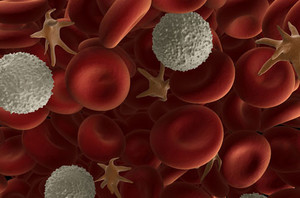Granulocyte colony-stimulating factors (G-CSF) stimulate white blood cell production and as such are indicated in the prophylaxis of chemotherapy-induced neutropenia (CIN) and febrile neutropenia (FN). Risk models of CIN/FN to date focus on predictors measured at the start of chemotherapy. Aapro and colleagues used a dynamic approach of CIN/FN risk modelling at the start of each cycle.
Predictive modelling of CIN prophylaxis with biosimilar filgrastim
Biosimilars/Research
|
Posted 09/06/2017
 0
Post your comment
0
Post your comment

The MONITOR-GCSF was a pan-European, multicentre, prospective, observational study of cancer patients treated with myelosuppressive chemotherapy regimens receiving CIN/FN prophylaxis with Zarzio as per their physician’s best clinical judgement [1]. Aapro and colleagues have previously reported results from MONITOR-GCSF including incidence rates for CIN grade 4 (CIN4), FN, CIN/FN-related hospitalizations and chemotherapy disturbance (dose reduction, discontinuation, or delay) [1].
In this analysis [2], they applied predictive modelling using multivariate logistic regression to identify determinants of CIN/FN episodes and related hospitalizations and chemotherapy disturbances (CIN/FN consequences) at the patient- (‘ever’ during the whole period of chemotherapy) and cycle-level (during a given chemotherapy cycle). Statistical dependence of cycle data being ‘nested’ under patients was managed using Generalized Estimation Equations. Adjusted odds ratios (OR) and 95% confidence intervals (95% CI) quantified the direction and strength of the relationship between predictors and outcomes. Predictive performance of each model was evaluated.
A total of 1,447 patients were included in the MONITOR-GCSF study. Static patient-level risk models of ‘ever’ experiencing CIN/FN adverse events and consequences during a planned chemotherapy regimen included predictors related to history; risk factors; and prophylaxis initiation and intensity. The risk of an FN episode was higher in patients who were under-prophylacted versus those who were over-prophylacted. Age was associated with lower risk of an FN episode. Dynamic cycle-level risk models of experiencing CIN/FN adverse events and consequences in an upcoming cycle included predictors related to history; risk factors; prophylaxis initiation, intensity and duration; CIN/FN in the prior cycle; and treatment centre characteristics.
The authors concluded that their ‘real-world’ models of predictors of patients experiencing neutropenic events ‘ever’ or within a given cycle may help physicians anticipate such outcomes. A dynamic approach of reassessing the likelihood of adverse CIN/FN events at each cycle supports clinicians in assessing risk at the start of each cycle and enables personalized treatment, in line with European Organisation for Research and Treatment of Cancer (EORTC) recommendations. Prophylaxis intensity is a major determinant of CIN/FN events. ‘Over-prophylaxis’ of patients receiving chemotherapy with intermediate or low myelotoxicity levels may have benefits to patients and must be validated in future studies. Future studies should also include relative dose intensity.
References
1. Gascón P, et al. Treatment patterns and outcomes in the prophylaxis of chemotherapy-induced (febrile) neutropenia with biosimilar filgrastim (the MONITOR-GCSF study). Support Care Cancer. 2016;24(2):911-25.
2. Aapro M, et al. Predictive modeling of the outcomes of chemotherapy-induced (febrile) neutropenia prophylaxis with biosimilar filgrastim (MONITOR-GCSF study). Ann Oncol. 2016;27(11):2039-45.
Permission granted to reproduce for personal and non-commercial use only. All other reproduction, copy or reprinting of all or part of any ‘Content’ found on this website is strictly prohibited without the prior consent of the publisher. Contact the publisher to obtain permission before redistributing.
Copyright – Unless otherwise stated all contents of this website are © 2017 Pro Pharma Communications International. All Rights Reserved.
News
FDA approves six denosumab biosimilars
EMA recommends approval for four biosimilars targeting three therapies
General
Samsung Bioepis wins Pyzchiva case; Regeneron patent rulings threaten foreign biosimilars
Chinese biosimilars go global: growth, partnerships, and challenges
What is the future for the US biosimilar interchangeability designation

Biosimilars/Research Posted 05/06/2025
Biosimilar clinical efficacy studies: are they still necessary?

Biosimilars/Research Posted 27/05/2025
The best selling biotechnology drugs of 2008: the next biosimilars targets








Post your comment